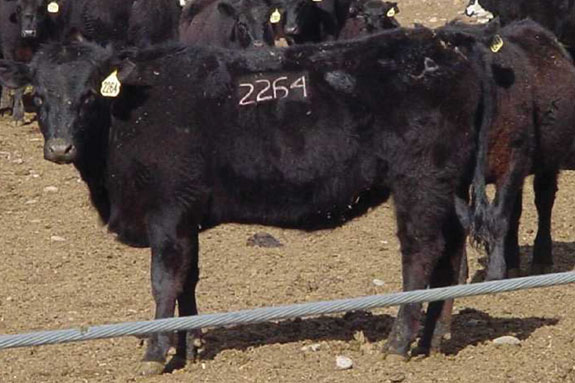Since its development, freeze branding has been used successfully when applied with the proper technique.
Freeze branding destroys the natural pigments in hair, thus producing the growth of white hair. This relatively painless method of branding reduces hide damage and can be used to completely remove the hair if the irons are held on the animal long enough. Such a method may be used on white-haired animals.
Oklahoma is one state that has legalized freeze branding for ownership and identification of cattle. This fact sheet includes the present procedures suggested for freeze branding based on experimental work.
What kind of irons should be used?
Research has shown that solid copper irons one-fourth to five-sixths of an inch thick, 1 inch to 1 1/2 inches from face to back and 4 inches high, are used very successfully. Brass, steel and aluminum branding irons have been used with less success.
Based on field trials some people have stated that they would prefer a 5-inch brand to a 4-inch brand. However, if more than one number is used on a brand, the 4-inch size is most often preferred. Freeze branding irons of various sizes are available in equipment and supply catalogs and stores.

How are irons cooled?
Several cooling solutions can be used with success. If the air is dry, 95 percent isopropyl, ethyl or methyl alcohol will work very well. When humid conditions exist or when using the same cooling solutions for several hours, alcohol loses its cooling capabilities because of taking up moisture from the air. The most practical coolant seems to be dry ice in gasoline. Gasoline does not take on water from the air and will maintain its cold temperature. It can be used for a half day and still retain a very cold temperature. Use of antifreeze has had little success.
How long should the irons cool?
The first time the irons are cooled 15 to 20 minutes. Thereafter, the irons should cool until the bubbles rising from them in the liquid are reduced to a minimum. No less than one to two minutes should be allowed between brands with the same iron.
Should the animal’s hair be clipped?
The hair must be clipped on the area to be branded, preferably with small animal clippers or surgical clippers; however, regular show animal clippers have been less successful. There is now a clipper head available commercially for clipping before freeze branding. This head attaches to the show clippers. The clipper heads can be obtained through supply catalogs and equipment stores. Time required for branding varies with the amount of short hair remaining. The shorter the hair, the less time required.
Is liquid applied to the clipped area?
Yes. Liquid should be applied after clipping and rubbed off to remove excess loose hair and dirt. A second application of liquid should take place just before the irons are applied. The liquid is necessary for transferring heat from the animal to the irons and aids in obtaining good brands. Alcohol is the best liquid to use for this purpose and can be used when either alcohol or gasoline is used as the liquid coolant. Gasoline can also be used as the cooling solution.
How long should the irons be applied?
The time varies with the age of the animal and the clippers used. Forty-five seconds appears to be the best time for mature cattle based on field trials. Young cattle need 35- to 40-second brands. However, if surgical clippers are used, 30-second brands consistently get excellent results. When liquid nitrogen is used as the coolant, 20 seconds is adequate for branding.
What time of year is best for branding?
About the time a new hair coat is starting, either in the spring or fall, is a good time. Successful brands have been accomplished at all times of the year; however, those done about the time a new hair coat is starting appear most rapidly. Those done after the new hair coat is on the animal may take three to four months for white hair to appear.
How soon can the brands be read?
The brand raises a welt on the animal as soon as the hide thaws and can be read immediately after branding. It usually is readable until the white hair appears. This may be 20 days to several months.

How long will it take?
The accompanying table presents data on animals branded in Oklahoma and Arizona. When proper techniques were used, freeze brands in Oklahoma have been about 82.2 percent readable. Professional freeze branding outfits often guarantee 95 percent take on the brands.
In this table you will note the use of gasoline as a liquid coolant with dry ice. Gasoline has been used successfully. On humid days gasoline is superior to alcohol since alcohol will take on water from the air over a few hours and become less effective as a coolant. Alcohol works exceptionally well on very dry days or when only a few head are to be branded and the coolant will be exposed to atmospheric conditions for only a short time.
Although 45 seconds appears to be the best time for freeze branding, this time is very dependent upon the clipper heads used. Cattle clipped with surgical clippers will require less time for branding whereas cattle clipped with regular show clippers will need 45 seconds or even more and then may not give good results. Excessive time of freeze branding will result in a brand with no hair at all on the skin.
Research has indicated that younger animals were more efficiently branded than were older cows. More of the brands on younger cows and calves were clearly readable due to the white hairs present.
Freeze branding takes about three to 10 minutes per head and costs about $0.05 per head or less when using dry ice. Cost is more than doubled if liquid nitrogen is used.
Equipment needed for freeze branding
- Cooper freeze branding irons – size depending upon the size of the cattle.
- Hair clippers – a special head is available for closer clipping.
- Source of electricity or a generator for power to run clippers.
- Container with cleaning solution for the clipper head.
- Container for the liquid coolant, preferably aluminum and large enough to contain all the irons. A special cooler is available for liquid nitrogen.
- Dry ice. Be sure enough is on hand. Approximately 50 to 75 pounds will be required for an 8- to 10-hour day of branding operation. Liquid nitrogen is often hard to obtain and arrangements for its purchase should be made in advance. If liquid nitrogen is used, no dry ice is needed.
- Container for solvent to squirt on the animal’s hide. An old soap container from the kitchen will work for this.
- Sack or cloth to rub off excess dirt.
- At least two men.
- Good working corrals and pens.
- Watch with second hand.
- Preferably someone to record brands for production records.
Step-wise procedure
- Use copper irons.
- Reduce the temperature of the liquid coolant to approximately -106 degrees C or -157 degrees F.
- Immerse the irons in a liquid coolant and dry ice bath. Make sure the liquid covers the irons completely.
- Allow at least 20 minutes for the irons to cool the first time.
- Meanwhile, move cattle up the chute and clip the area to be branded. Avoid branding on the flank or paunch area.
- Clip the area to be branded. Fine- headed clippers are desired.
- Soak the clipped area with the same solvent as used in the dry ice.
- Rub off the liquid.
- Re-soak the area and apply the cold branding irons.
- Apply the irons firmly for 40 to 45 seconds – some less if fine-headed clippers are used.
- Time with a stop watch.
- After each animal is clipped, wash the clipper head in a small can of liquid solvent.
- If a branding iron needs to be used twice, such as 22 or 33, allow at least one minute, preferably more, for the irons to cool between brandings.
Summary
Freeze brands have remained readable on some animals for five to six years. However, it is still questionable if freeze branding is desired for ownership brands.
Safety considerations
Anytime you use gasoline or any other flammable substance, you should be aware of the hazards involved. The potential explosive power of gasoline is tremendous. One gallon of gasoline, which has vaporized and mixed with the proper amount of air, can produce an explosion equal to 83 pounds of dynamite. Since gasoline will mix with air to form an explosive mixture at as low as 50 degrees F, it is important that certain precautions be taken.
- Keep flames or other potential sources of sparks, such as cigarettes, away from the branding operation.
- Be extremely careful with the gasoline while it is cooling down at the beginning of the operation and again as it is warming up at the end. During this period it is warm enough to vaporize and combine with air to form an explosive mixture.
- Keep any extra supply of gasoline that is not being used as a cooling solution in an approved safety container.
- Have a suitable Class B fire extinguisher readily available in the event a fire does start.
- Avoid prolonged skin contact with gasoline. Wash hands thoroughly before eating or before becoming exposed to a flame such as lighting a cigarette.
This article originally appeared in the Oklahoma Beef Extension newsletter.
PHOTOS
MIDDLE: Research has shown that solid copper irons one-fourth to five-sixths of an inch thick, 1 inch to 1 1/2 inches from face to back and 4 inches high, are used very successfully.
BOTTOM: Freeze branding destroys the natural pigments in hair, thus producing the growth of white hair.

Dave Lalman
Professor,
Beef Cattle Specialist
Oklahoma State University
david.lalman@okstate.edu







